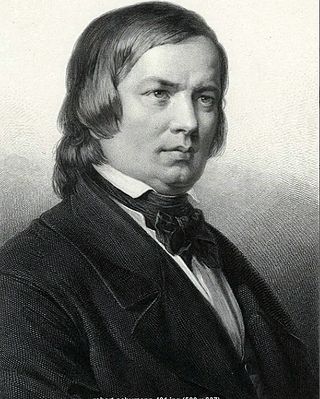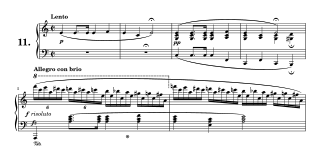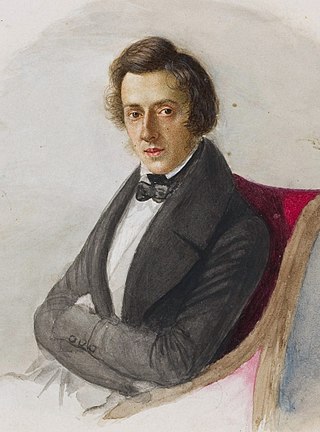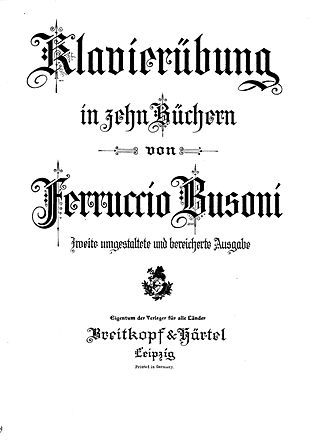Related Research Articles

Music lessons are a type of formal instruction in playing a musical instrument or singing. Typically, a student taking music lessons meets a music teacher for one-to-one training sessions ranging from 30 minutes to one hour in length over a period of weeks or years. Depending on lessons to be taught, students learn different skills relevant to the instruments used. Music teachers also assign technical exercises, musical pieces, and other activities to help the students improve their musical skills. While most music lessons are one-on-one (private), some teachers also teach groups of two to four students, and, for very basic instruction, some instruments are taught in large group lessons, such as piano and acoustic guitar. Since the widespread availability of high speed. low latency Internet, private lessons can also take place through live video chat using webcams, microphones and videotelephony online.

Robert Schumann was a German composer, pianist, and influential music critic. He is widely regarded as one of the greatest composers of the Romantic era. Schumann left the study of law, intending to pursue a career as a virtuoso pianist. His teacher, Friedrich Wieck, a German pianist, had assured him that he could become the finest pianist in Europe, but a hand injury ended this dream. Schumann then focused his musical energies on composing.

Chamber music is a form of classical music that is composed for a small group of instruments—traditionally a group that could fit in a palace chamber or a large room. Most broadly, it includes any art music that is performed by a small number of performers, with one performer to a part. However, by convention, it usually does not include solo instrument performances.

The Piano Sonata No. 14 in C-sharp minor, marked Quasi una fantasia, Op. 27, No. 2, is a piano sonata by Ludwig van Beethoven. It was completed in 1801 and dedicated in 1802 to his pupil Countess Julie "Giulietta" Guicciardi. The name Moonlight Sonata grew popular later, likely after Beethoven's death.

An étude or study is an instrumental musical composition, usually short, designed to provide practice material for perfecting a particular musical skill. The tradition of writing études emerged in the early 19th century with the rapidly growing popularity of the piano. Of the vast number of études from that era some are still used as teaching material, and a few, by major composers such as Frédéric Chopin, Franz Liszt and Claude Debussy, achieved a place in today's concert repertory. Études written in the 20th century include those related to traditional ones and those that require wholly unorthodox technique.

Karl Tausig was a Polish virtuoso pianist, arranger and composer. He is generally regarded as Franz Liszt's most distinguished pupil and one of the greatest pianists of all time.
The Orff Schulwerk, or simply the Orff Approach, is a developmental approach used in music education. It combines music, movement, drama, and speech into lessons that are similar to a child's world of play. It was developed by the German composer Carl Orff (1895–1982) and colleague Gunild Keetman during the 1920s. Carl Orff worked until the end of his life to continue the development and spread of his teaching method.

AntonJoseph Reicha (Rejcha) was a Czech-born, Bavarian-educated, later naturalized French composer and music theorist. A contemporary and lifelong friend of Beethoven, he is now best remembered for his substantial early contributions to the wind quintet literature and his role as teacher of pupils including Franz Liszt, Hector Berlioz and César Franck. He was also an accomplished theorist, and wrote several treatises on various aspects of composition. Some of his theoretical work dealt with experimental methods of composition, which he applied in a variety of works such as fugues and études for piano and string quartet.
Tempo rubato is a musical term referring to expressive and rhythmic freedom by a slight speeding up and then slowing down of the tempo of a piece at the discretion of the soloist or the conductor. Rubato is an expressive shaping of music that is a part of phrasing.

Émile Jaques-Dalcroze was a Swiss composer, musician, and music educator who developed Dalcroze eurhythmics, an approach to learning and experiencing music through movement. Dalcroze eurhythmics influenced Carl Orff's pedagogy, used in music education throughout the United States.
Abby Whiteside was an American piano teacher. She challenged the finger-centric approach of much classical piano teaching and instead advocated a holistic attitude in which the arm and torso are the conductors of a musical image conceived first in the mind.

The Études by Frédéric Chopin are three sets of études for the piano published during the 1830s. There are twenty-seven compositions overall, comprising two separate collections of twelve, numbered Op. 10 and Op. 25, and a set of three without opus number.

Étude Op. 10, No. 1 in C major is a study for solo piano composed by Frédéric Chopin in 1829. It was first published in 1833 in France, Germany, and England as the first piece of his Études Op. 10. This study in reach and arpeggios focuses on stretching the fingers of the right hand. The American music critic James Huneker (1857–1921) compared the "hypnotic charm" that these "dizzy acclivities and descents exercise for eye as well as ear" to the frightening staircases in Giovanni Battista Piranesi's prints of the Carceri d'invenzione. Virtuoso pianist Vladimir Horowitz, who refused to perform this étude in public, said, "For me, the most difficult one of all is the C Major, the first one, Op. 10, No. 1."

Étude Op. 10, No. 2, in A minor, is a technical study composed by Frédéric Chopin for the piano. It was preceded by a relative major key. Composed in November 1829, it was first published in 1833 in France, Germany, and England. This étude is an exercise in developing the independence of the weaker fingers of the right hand by playing rapid chromatic scale figures with the third, fourth, and fifth fingers of the right hand. Meanwhile, the first two fingers of the right and the left hand play an accompaniment of short intervals and single notes. Chopin indicated the fingering himself note by note for almost 800 notes.

Étude Op. 10, No. 3, in E major, is a study for solo piano composed by Frédéric Chopin in 1832. It was first published in 1833 in France, Germany, and England as the third piece of his Études Op. 10. This is a slow cantabile study for polyphonic and expressive legato playing. In fact, Chopin himself believed the melody of the piece to be the most beautiful one he ever composed. It became famous through numerous popular arrangements. Although this étude is sometimes identified by the names "Tristesse" (Sadness) or "Farewell (L'Adieu)", neither is a name given by Chopin, but rather his critics.

Isidor Edmond Philipp was a French pianist, composer, and pedagogue of Jewish Hungarian descent. He was born in Budapest and died in Paris.

Demetrius Constantine Dounis, also known as D. C. Dounis, was an influential teacher of violin and string instrument technique, as well as violinist, violist, and mandolin player.

Piano pedagogy is the study of the teaching of piano playing. Whereas the professional field of music education pertains to the teaching of music in school classrooms or group settings, piano pedagogy focuses on the teaching of musical skills to individual piano students. This is often done via private or semiprivate instructions, commonly referred to as piano lessons. The practitioners of piano pedagogy are called piano pedagogues, or simply, piano teachers.

The Klavierübung, by the Italian pianist-composer Ferruccio Busoni, is a compilation of piano exercises and practice pieces, comprising transcriptions of works by other composers and original compositions of his own.
Dispokinesis is a form of training and therapy specially developed for musicians and stage artists by Gerrit Onne van de Klashorst (Netherlands). First scientific evidence for the effect of Dispokinesis on musicians, both professional and musicians-in-training, has been published. Dispokinesis can be employed in a pedagogy and preventive medicine setting as well as in therapy and rehabilitation. By means of the Original Shapes of Movement and Posture, the human being's sensori- and psychomotor development is being worked through from lying down to crawling to the upright standing position. By doing so, possibly existing developmental gaps can be closed and especially the postural reflexes are being fostered. Specific exercises focussing on instrumental and vocal technique as well as ergonomic aids developed in connection with Dispokinesis also play an important role. Among them can be found sitting aids for instruments played in orchestra and for the keyboard family, chin rests and shoulder pads for the upper strings or belts, thumb or knee-supports for wind and plucked instruments. The competence in instrumental and vocal technique as well as body awareness and expressivity are consistently developed in view of the requirements to be met on stage.
References
- ↑ Five finger exercise on the Piano-play-it website
- ↑ Für Elise as a piano exercise
- ↑ Examples of the score for other instruments
- ↑ Für Elise on the guitar (as an exercise)
- ↑ Riley, Kathleen; Coons, Edgar E.; Marcarian, David (June 2005). "The Use of Multimodal Feedback in Retraining of Complex Technical Skills of Piano Performance". Medical Problems of Performing Artists. 20 (2): 82. CiteSeerX 10.1.1.88.3005 . doi:10.21091/mppa.2005.2016.
- ↑ The art of piano playing: a scientific approach on the Google books website
- ↑ e.g. John R. Searle, Intentionality, p. 33; Tamar Gendler, "Alief and Belief"
- ↑ e.g. Wilson, C. "Roles for an Effective Board: A Five-Finger Exercise. Part I." Hospital Trustee (January/February 1984): 16-18.
- ↑ Morris Freedman, "Finger Exercises", College English16:4:245 (January 1955) JSTOR 372589
- ↑ "Five Finger Exercise" in Anthony L. Dunnavant, D. Newell Williams, Douglas A. Foster, Paul M. Blowers, eds., The Encyclopedia of the Stone-Campbell Movement, 2004, ISBN 0802838987, p. 338